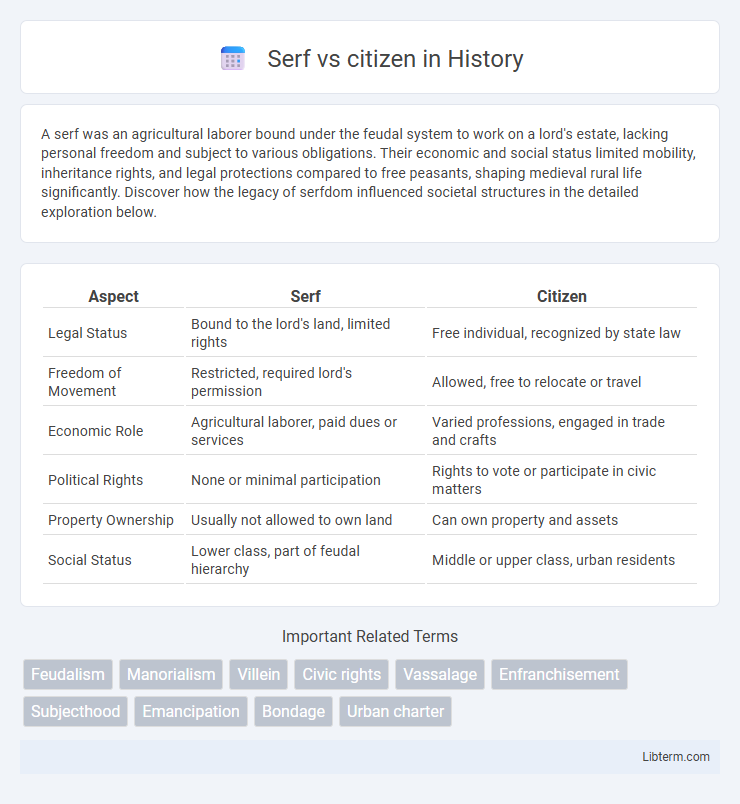A serf was an agricultural laborer bound under the feudal system to work on a lord's estate, lacking personal freedom and subject to various obligations. Their economic and social status limited mobility, inheritance rights, and legal protections compared to free peasants, shaping medieval rural life significantly. Discover how the legacy of serfdom influenced societal structures in the detailed exploration below.
Table of Comparison
| Aspect | Serf | Citizen |
|---|---|---|
| Legal Status | Bound to the lord's land, limited rights | Free individual, recognized by state law |
| Freedom of Movement | Restricted, required lord's permission | Allowed, free to relocate or travel |
| Economic Role | Agricultural laborer, paid dues or services | Varied professions, engaged in trade and crafts |
| Political Rights | None or minimal participation | Rights to vote or participate in civic matters |
| Property Ownership | Usually not allowed to own land | Can own property and assets |
| Social Status | Lower class, part of feudal hierarchy | Middle or upper class, urban residents |
Introduction to Serf and Citizen
Serfs were unfree agricultural laborers bound to the land under the feudal system, lacking personal freedom and subject to the control of a lord. Citizens, in contrast, held legal rights and privileges within a city or state, enjoying political participation and personal autonomy. The distinction between serf and citizen highlights the shift from feudal dependency to civic identity and rights in medieval and early modern societies.
Historical Background and Origins
Serfs originated in medieval Europe as agrarian laborers bound to the land under the feudal system, where they provided services to a lord in exchange for protection. Citizens, contrastingly, emerged from ancient city-states like Athens and Rome, possessing legal rights and political participation within organized urban communities. The historical shift from serfdom to citizenship reflects broader social, economic, and political transformations, including the decline of feudalism and the rise of centralized states.
Social Status and Rights
Serfs occupied the lowest social status in feudal society, bound legally to their lord's land with limited personal freedoms, forced to provide labor and pay dues without ownership rights. Citizens, often residing in towns or cities, enjoyed higher social status with greater legal protections, property ownership, and participation in local governance. The stark contrast between serfs' obligations and citizens' rights highlights the rigid social hierarchy and unequal distribution of power in medieval Europe.
Economic Role and Responsibilities
Serfs were legally bound to their lord's land, providing labor and a portion of agricultural produce as rent, limiting their economic autonomy and ability to accumulate wealth. Citizens, typically in towns or cities, engaged in diverse economic activities such as trade, crafts, and commerce, enjoying greater rights to own property and participate in market economies. The economic responsibilities of citizens included paying taxes, contributing to guilds, and supporting municipal infrastructure, contrasting with the serfs' primary obligation to sustain the feudal estate through labor.
Legal Protections and Limitations
Serfs were legally bound to the land and subject to the authority of their lords, lacking personal freedom and limited legal protections, as they could not own property or move without permission. Citizens enjoyed recognized rights under the law, including property ownership, legal recourse, and participation in municipal governance, providing greater personal autonomy. Legal systems during feudal times distinctly favored citizens, granting them protections such as contract enforcement and the right to appeal, which were largely inaccessible to serfs.
Freedom of Movement and Decision-making
Serfs were legally bound to the land they worked on, severely restricting their freedom of movement and requiring permission from their lord to travel or relocate. Citizens, in contrast, generally enjoyed greater autonomy, possessing the right to move freely within their city or country and make independent decisions regarding residence and occupation. This fundamental difference underscored the broader disparities in personal liberty and social status between serfs and citizens in medieval and early modern societies.
Taxation and Obligations
Serfs were legally bound to their lord's land and owed labor, produce, and various taxes such as the tithe and feudal dues, limiting their economic freedom and mobility. Citizens, particularly in medieval towns, paid regulated taxes like poll taxes, property taxes, and market tolls, with obligations tied to civic duties such as militia service and guild participation. The fiscal responsibilities of serfs were primarily feudal and agricultural, while citizens faced structured municipal taxation with corresponding legal rights and privileges.
Pathways to Social Mobility
Serfs faced severe limitations on social mobility due to their legally bound status and dependence on landowners, restricting access to education and property ownership. In contrast, citizens in medieval towns had greater opportunities for upward mobility through guild membership, trade, and civic participation, enabling wealth accumulation and social influence. Legal rights and economic freedom were key pathways distinguishing the potential for social advancement between serfs and citizens.
Societal Contributions and Influence
Serfs primarily contributed to medieval agrarian economies through labor-intensive farming, sustaining feudal lords and local economies without direct political influence or legal rights. In contrast, citizens in urban centers actively shaped societal structures via commerce, crafts, and participation in town governance, influencing emerging economic and political institutions. This distinction highlights the transformative impact of citizenship on social mobility, economic diversification, and civic engagement during the transition from feudalism to early modern societies.
Modern Implications and Comparisons
Serfs, historically bound to the land and subject to feudal lords, contrast sharply with modern citizens who possess legal rights and political freedoms within nation-states. The transition from serfdom to citizenship reflects significant socio-political evolution, emphasizing individual autonomy, property rights, and participatory governance. Contemporary implications of this shift include enhanced social mobility, democratic accountability, and expanded civil liberties, highlighting the ongoing global struggle to balance state authority and personal freedom.
Serf Infographic

 libterm.com
libterm.com